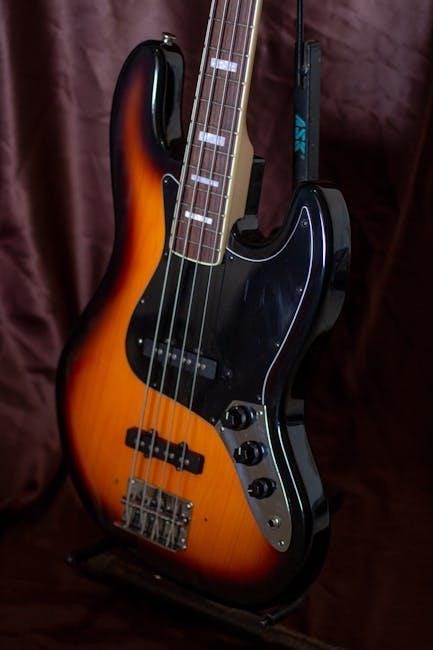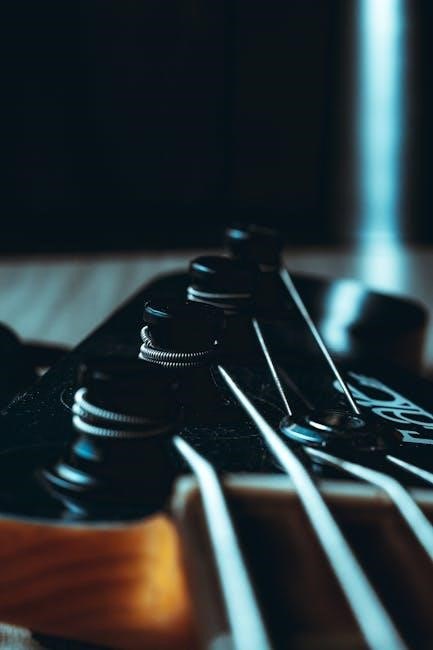The bass guitar is a foundational instrument in music‚ providing rhythm and harmony. It plays root notes‚ defining the key and groove of a song. Learning the fretboard and basic techniques helps beginners establish a strong musical foundation.
The Role of a Bass Guitarist
The bass guitarist plays a pivotal role in music‚ providing the rhythmic and harmonic foundation of a song. By playing root notes‚ the bassist defines the key and groove‚ working closely with the drummer to create a solid rhythm section. The bassist supports the melody and chord progression‚ often acting as the bridge between rhythm and harmony. Their role is collaborative‚ ensuring the music flows cohesively. While not always in the spotlight‚ the bassist is essential‚ anchoring the band and giving depth to the overall sound. This foundational role requires a strong sense of rhythm and timing‚ as well as the ability to complement other instruments seamlessly.
The Importance of Root Notes
Root notes are the foundation of a chord‚ establishing its tonal center and harmonic identity. For bassists‚ playing root notes is crucial as it defines the key of the song and provides clarity to the chord progression. Root notes anchor the music‚ ensuring that the rhythm section stays aligned and the overall sound remains cohesive. They guide the listener’s ear and help establish the musical structure. By emphasizing root notes‚ bassists create a solid harmonic and rhythmic foundation‚ allowing other instruments to explore melodic and harmonic possibilities. Mastering root notes is essential for beginners‚ as it builds a strong musical understanding and enhances groove and timing. This fundamental technique is vital for any bassist aiming to provide a clear and impactful musical foundation.

Learning the Notes on the Fretboard
Mastering the notes on the bass guitar fretboard is essential for beginners. It provides a clear understanding of where notes are located‚ enabling accurate playing. PDF resources and workbooks offer detailed fretboard charts‚ exercises‚ and tips to help memorize notes effectively. Start by learning the notes on each string‚ beginning with the basics. Practice regularly‚ using downloadable charts to reinforce your knowledge. Understanding the fretboard layout helps in navigating smoothly during play. Consistent practice and repetition are key to building familiarity and confidence. As you progress‚ you’ll find it easier to play chords‚ scales‚ and melodies. Learning the notes is a foundational step that enhances your overall bass-playing skills and opens the door to more complex techniques and musical exploration.

Getting Started with Bass Guitar
Begin with choosing the right bass‚ setting it up‚ and learning proper holding techniques. Start with basic plucking methods and explore PDF resources for guided lessons and exercises.
Choosing the Right Bass Guitar
Choosing the right bass guitar is crucial for beginners. Start with a standard 4-string bass‚ as it is easier to handle and more versatile. Consider the action (string height) and electronics‚ as these affect playability and tone. Acoustic or electric basses are options‚ but electric basses are more common. Ensure the body style is comfortable for your size and preference. Budget-friendly models are available without sacrificing quality. Visit music stores to try different basses before purchasing. Many resources‚ including PDF guides‚ provide detailed comparisons and recommendations. Proper fit and feel are essential for enjoyable learning and practice. A well-chosen bass guitar will enhance your playing experience and motivation to progress.
Setting Up Your Bass Guitar
Setting up your bass guitar ensures optimal playability and sound. Adjust the bridge to balance string tension and action. Lower the action for easier fretting‚ but avoid buzzing. Tune the bass regularly‚ using a tuner for accuracy. Check the neck alignment and adjust the truss rod if necessary to prevent warping. Install new strings if needed‚ as old strings can dampen sound quality. Properly setting up your bass enhances comfort and performance. Many PDF guides offer step-by-step instructions for beginners‚ ensuring a professional setup without professional assistance. A well-adjusted bass guitar is essential for effective practice and enjoyable playing.
Holding the Bass Guitar Correctly
Holding the bass guitar correctly is crucial for comfort and proper technique. Stand or sit with good posture‚ keeping the bass at a slight angle. When standing‚ use a strap to support the instrument‚ ensuring the neck is parallel to the floor. When sitting‚ rest the bass on your left leg‚ balancing it evenly. Grip the neck lightly but firmly with your left hand‚ placing your thumb over the top for control. Your right hand should pluck the strings near the bridge for optimal tone. Avoid slouching or holding the bass too low‚ as this can strain your back and hands. Properly holding the bass allows for better access to the fretboard and ensures a comfortable playing experience. Many PDF guides provide visual aids to help beginners master this essential step.
Basic Hand Positioning
Proper hand positioning is vital for playing the bass guitar effectively. For the left hand‚ place your fingers close to the fretboard‚ pressing the strings firmly behind the fret to ensure clear notes. Avoid bending your wrists awkwardly‚ as this can lead to discomfort and fatigue. For the right hand‚ position your thumb and fingers to pluck or strum the strings. If using a pick‚ hold it between your thumb and index finger‚ with your other fingers supporting from below. When plucking with fingers‚ keep your thumb near the bridge for better control. PDF guides often include detailed illustrations to help beginners achieve the correct hand placement‚ ensuring proper technique and avoiding common mistakes that can hinder progress. Maintain relaxed hands to facilitate smooth transitions between notes and chords. This foundational step is essential for developing a solid playing technique.
Plucking Techniques for Beginners
Mastering plucking techniques is fundamental for bass guitar beginners. Start with the basic fingerstyle method‚ using your index and middle fingers to pluck the strings. Keep your fingers close to the strings to produce a clear‚ resonant sound. For added dynamics‚ experiment with your thumb‚ which can provide a deeper‚ punchier tone. When using a pick‚ hold it firmly but not too tightly‚ and focus on consistent up-and-down strokes. PDF guides often include exercises to improve plucking accuracy and rhythm. Practice plucking individual strings to build finger strength and dexterity. Gradually incorporate simple rhythms and syncopation to enhance your timing. Regular practice will help you develop a smooth‚ expressive plucking technique‚ essential for playing various musical styles. Remember to stay relaxed and avoid tension in your hands to maintain a natural‚ flowing sound.
Understanding Basic Music Theory
Understanding basic music theory is crucial for bass guitar beginners. It provides the foundation for playing effectively and improvising. Start by learning the basics of notes‚ rhythm‚ timing‚ and scales. Familiarize yourself with the concept of root notes‚ which define the key and harmony of a song. Learn how chords are built and how they progress in a song‚ as this will help you understand the structure of music. PDF guides often include exercises to practice reading sheet music and tabs‚ which are essential for mastering bass lines. Focus on how scales relate to chords‚ as this relationship is key to creating melodies and solos. Regular practice will help you apply these concepts intuitively‚ enabling you to play with confidence and creativity. Music theory is the backbone of every great bass line‚ so take the time to grasp these fundamentals.

Essential Techniques
Mastering plucking‚ scales‚ and timing is vital. PDF guides offer exercises to improve finger dexterity and rhythm‚ helping beginners develop a solid foundation for advanced techniques.
Playing Your First Notes
Starting with the open E string‚ focus on proper hand positioning and plucking technique. Use a tuner to ensure accuracy. Begin by plucking the E string with your index finger‚ ensuring a clean‚ clear sound. Gradually move to the A‚ D‚ and G strings‚ practicing each individually. Pay attention to finger placement to avoid muting adjacent strings. Once comfortable‚ try playing a simple sequence like E-A-D-G‚ repeating it to build rhythm. Use a metronome to improve timing. As you progress‚ incorporate basic scales and simple melodies. Remember‚ consistency is key—practice even a few minutes daily. Downloadable PDF resources‚ like fretboard charts‚ can help you visualize the notes and improve your fingering. Keep it fun and rewarding by celebrating small milestones in your journey to becoming a skilled bassist.
Mastering basic scales is essential for any bassist‚ as they form the foundation of melodies and solos. Start with the major scale‚ focusing on the E major scale‚ as it aligns with the bass guitar’s tuning. Practice playing each note cleanly‚ ensuring proper fingering. The minor scale is next‚ introducing a different emotional tone. Begin with the E minor scale‚ paying attention to the intervals. Use a metronome to improve timing and accuracy. Break scales into smaller sections for easier learning. Downloadable PDF resources provide fretboard diagrams and exercises to help memorize scales. As you progress‚ experiment with playing scales in different keys to expand your versatility. Remember‚ scales are tools to create music‚ so apply them to real songs and melodies to enhance your playing.
Developing Rhythmic Techniques

Mastering rhythmic techniques is vital for bassists‚ as rhythm drives the music. Start by playing cleanly‚ ensuring each note is clear and well-timed. Use a metronome to improve your timing and accuracy. Begin with basic patterns like quarter notes and eighth notes‚ gradually incorporating syncopation for added complexity. Practice playing along with songs to develop your groove and timing. Focus on playing with a consistent‚ steady pulse‚ as this is the backbone of rhythm. Experiment with different time signatures to broaden your skills. Downloadable PDF resources offer exercises and worksheets to help refine your rhythmic playing. Regular practice will enhance your ability to lock in with drummers and other musicians‚ making you a solid and dependable bassist.

Music Theory and Reading

Understanding chords and progressions is essential for bassists. Reading sheet music and tabs helps master the instrument. PDF resources provide exercises to improve music theory and reading skills effectively.
Understanding Chords and Progressions
Chords and progressions form the backbone of music‚ guiding the harmonic structure. For bassists‚ understanding these concepts is crucial to playing in tune with the band; Root notes‚ scales‚ and chord tones help define the key and rhythm. PDF resources and workbooks provide exercises to master these fundamentals‚ ensuring a strong foundation. Learning to identify chord changes and play along with progressions enhances timing and groove. This skill allows bassists to support melodies effectively‚ creating a cohesive sound. Practicing chord charts and scales from PDF guides helps build familiarity and confidence. Understanding these elements is essential for beginners to progress and contribute meaningfully to music.

Reading Sheet Music and Tabs
Reading sheet music and tabs is essential for bass guitar beginners to understand musical notation and play accurately. Sheet music provides a visual representation of notes‚ rhythms‚ and timing‚ while tabs simplify fretboard navigation by showing strings and fret numbers. PDF guides and workbooks often include exercises to improve sight-reading skills‚ helping beginners grasp these concepts. Tabs are particularly useful for learning songs quickly‚ as they illustrate exact finger placements. Practicing with sheet music enhances musical literacy‚ while tabs offer a user-friendly alternative for those new to reading music. Both tools are covered in PDF resources‚ ensuring beginners can develop the skills needed to play confidently and accurately.

Practice and Resources
Daily practice routines and structured resources‚ such as PDF workbooks‚ help beginners master bass guitar techniques. These tools provide exercises‚ fretboard charts‚ and lessons to enhance learning and progress effectively.
Creating a Daily Practice Routine
A well-structured practice routine is essential for improving bass guitar skills. Start with short‚ focused sessions of 15-30 minutes‚ gradually increasing as you build stamina. Dedicate time to warm-ups‚ such as finger exercises and scales‚ to improve dexterity and accuracy. Allocate time for learning new techniques‚ like plucking or slapping‚ and practice playing along with songs to develop rhythm and timing. Incorporate music theory by reviewing chord progressions and root notes. Use PDF resources or workbooks for guided exercises and track your progress. Consistency is key‚ so set aside time each day to ensure steady improvement and enjoyment of the learning process.
Using PDF Resources Effectively
PDF resources are invaluable for learning bass guitar‚ offering structured lessons and exercises. Download a 34-page illustrated workbook with exercises tailored for each lesson to guide your progress. Utilize fretboard charts and rhythm worksheets to memorize notes and improve timing. These resources often include tips for mastering techniques and understanding music theory. Organize your practice by incorporating PDF materials into your daily routine‚ ensuring consistent improvement. Accessible without registration‚ these resources provide a comprehensive learning path. Focus on exercises that strengthen finger dexterity and scale mastery. Use PDFs to track your progress and reinforce new skills‚ making them a cornerstone of your learning journey.

Exploring Online Courses
Online courses offer a structured approach to learning bass guitar‚ starting from the basics. They cover essential topics like technique‚ reading music‚ and theory. These courses are designed for beginners‚ ensuring a gradual progression in skill level. Many include video lessons‚ interactive exercises‚ and downloadable materials. Some courses focus on mindset and groove‚ helping students develop a musical ear. They often cover gear setup and how to thrive in a band. With clear explanations and a lesson-by-lesson structure‚ online courses provide a comprehensive learning experience. They are ideal for those who prefer guided instruction and want to build a strong foundation in bass playing. Enrolling in an online course can accelerate your learning and help you achieve your musical goals efficiently.
